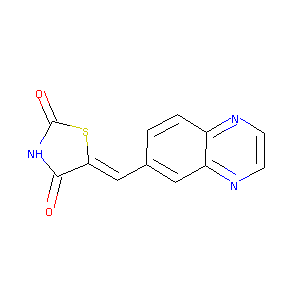Details of the Drug
General Information of Drug (ID: DMVX063)
| Drug Name |
5-QUINOXALIN-6-YLMETHYLENE-THIAZOLIDINE-2,4-DIONE
|
||||||||||||||||||||||
|---|---|---|---|---|---|---|---|---|---|---|---|---|---|---|---|---|---|---|---|---|---|---|---|
| Synonyms |
5-Quinoxalin-6-ylmethylene-thiazolidine-2,4-dione; AS-605240; 648450-29-7; AS605240; AS 605240; CHEMBL568150; (5Z)-5-(quinoxalin-6-ylmethylidene)-1,3-thiazolidine-2,4-dione; (5E)-5-(QUINOXALIN-6-YLMETHYLENE)-1,3-THIAZOLIDINE-2,4-DIONE; 5-(6-QUINOXALINYLMETHYLENE)-2,4-THIAZOLIDINEDIONE; QYT; (Z)-5-(Quinoxalin-6-ylmethylene)thiazolidine-2,4-dione; PI 3-Kg inhibitor; 2a5u; AC1NRCY0; 5-(quinoxalin-6-ylmethylene)thiazolidine-2,4-dione; SCHEMBL668616; GTPL6023; AOB3848; MolPort-006-169-944; HMS3650I15
|
||||||||||||||||||||||
| Indication |
|
||||||||||||||||||||||
| Drug Type |
Small molecular drug
|
||||||||||||||||||||||
| Structure |
 |
||||||||||||||||||||||
| 3D MOL | 2D MOL | ||||||||||||||||||||||
| #Ro5 Violations (Lipinski): 0 | Molecular Weight (mw) | 257.269 | |||||||||||||||||||||
| Logarithm of the Partition Coefficient (xlogp) | 1.5 | ||||||||||||||||||||||
| Rotatable Bond Count (rotbonds) | 1 | ||||||||||||||||||||||
| Hydrogen Bond Donor Count (hbonddonor) | 1 | ||||||||||||||||||||||
| Hydrogen Bond Acceptor Count (hbondacc) | 5 | ||||||||||||||||||||||
| Chemical Identifiers |
|
||||||||||||||||||||||
| Cross-matching ID | |||||||||||||||||||||||
Molecular Interaction Atlas of This Drug
 Drug Therapeutic Target (DTT) |
|
|||||||||||||||||||||||||||||||
|---|---|---|---|---|---|---|---|---|---|---|---|---|---|---|---|---|---|---|---|---|---|---|---|---|---|---|---|---|---|---|---|---|
| Molecular Interaction Atlas (MIA) | ||||||||||||||||||||||||||||||||
Molecular Expression Atlas of This Drug
| The Studied Disease | Discovery agent | |||||||||||||||||||||||
|---|---|---|---|---|---|---|---|---|---|---|---|---|---|---|---|---|---|---|---|---|---|---|---|---|
| ICD Disease Classification | N.A. | |||||||||||||||||||||||
|
||||||||||||||||||||||||
| Molecular Expression Atlas (MEA) | ||||||||||||||||||||||||
